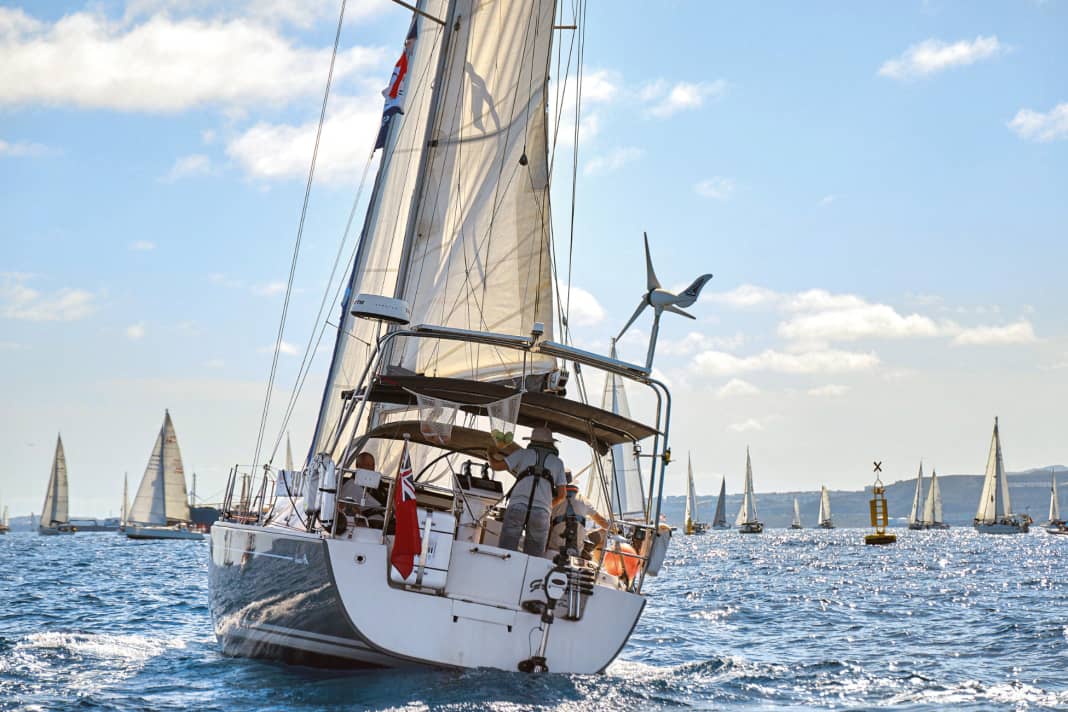





In this article:
It's almost like being at a boat show: Anyone strolling along the jetties in Las Palmas de Gran Canaria in November can hardly stop looking, marvelling and getting lost in discussions. The topic, quite clearly: the yachts moored here and their equipment. Some of them are so lavish that it is not immediately obvious what kind of ship is actually hidden underneath. Equipment carriers are enthroned at the sterns, with antennas, solar cells and even more antennas on top. Dinghies hang underneath. Behind the stern anchor, fishing rod, outboard motor, wind steering system, life raft and much more, the home harbour can hardly be made out on some of the sterns.
The difference to the trade fair: The dialogue partners are not salespeople, but the owners of the highly equipped yachts. They want to sail across the ocean together from here as part of the Atlantic Rally for Cruisers (ARC). Many of them have a marathon of equipment behind them and have already gained experience with some of it. Quite a few crews have plans to sail further around the world after the Atlantic and have prepared their ships accordingly.
A good place to see clever solutions and find out how long-distance sailors are equipping their boats these days, especially on deck, what trends and topics are on their minds, what is a must - and what perhaps is not.
We present four very different types of long-distance boats that are regularly in the fleet in more detail. Because there is certainly no such thing as the perfect blue water yacht. The needs are too different, the budget for boat and equipment too varied. If one person can make it across the pond in a 20-foot boat, the next considers a 20-metre yacht to be a nutshell. The fact that the perfect long-distance yacht does not necessarily have to be a robust go-anywhere steamer with an aluminium hull and deck saloon is illustrated by the boats selected here. They have been consistently designed for their specific purpose and show what is possible.
Nevertheless, one trend stands out: the yachts are getting bigger and newer. Only a good 10 to 15 per cent of the boats that sailed with the ARC in 2022 were less than twelve metres long. Boats around 30 feet are a rarity and by far the smallest. The average boat length was around 14.50 metres. The number of new yachts from shipyards is also increasing, especially the proportion of new catamarans. Of the 16 newbuilds in the 2022 ARC fleet, 15 were multihulls. Although this is only a small proportion of the fleet of almost 150 boats, it is a rapidly growing one.
We present these four types of long-distance yachts.
Type 1: the solid family boat
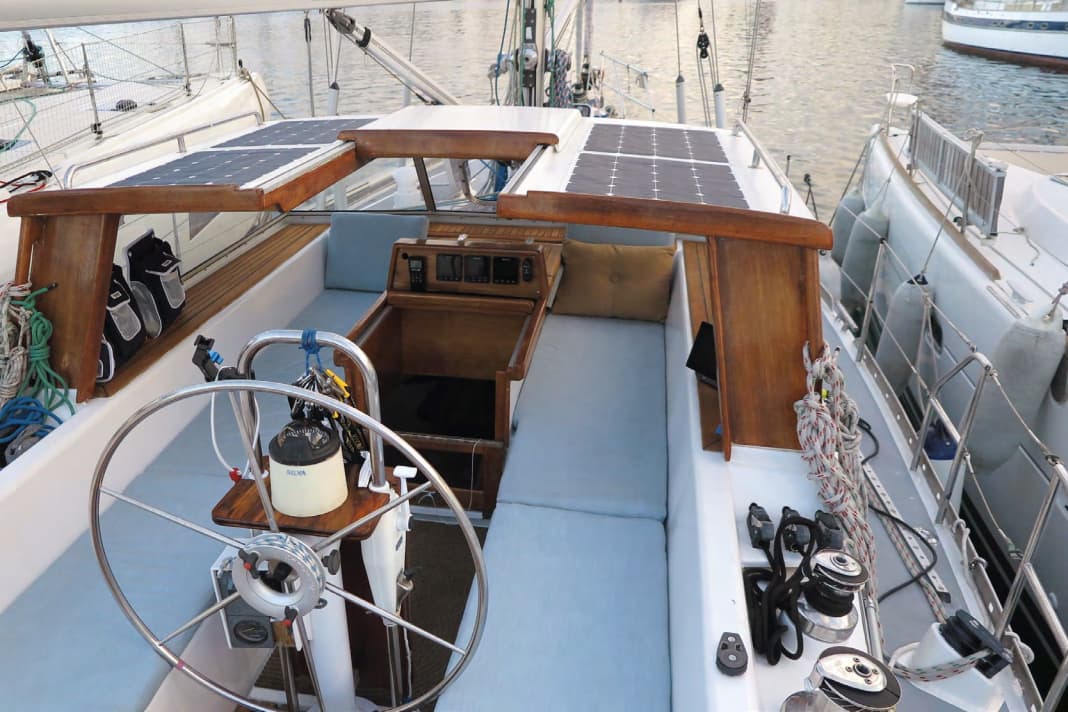




The type of boat with which the Heggelund Hansen family from Oslo is planning a long voyage is hardly known. Only a few examples of the Swedish steel ship were built. For the family with two children aged seven and eleven, the purchase was a hit: the crew will be safe at sea in the centre cockpit. Half of it is covered, which not only provides protection from the sun, rain and rough seas, but also offers space for mounting the solar panels - especially as there is no equipment rack. Everything on the boat has been consistently designed for safe sailing with a small family crew. The headsails of the cutter-rigged rig are unfurled with two spinnaker booms and can be reefed, furled and unfurled from the cockpit. Mast steps lead up to the top. An electric autopilot and a Windpilot Pacific self-steering system complement each other and take over the steering at sea. The highlight for the kids: the bathing platform for mooring with dinghy and SUP.
It is a heavy and safe ship for the north, where we come from. But it will also be ideal for our year of sailing on the Atlantic". Owner Hilde Heggelund Hansen
Technical data of theLångedrag 401 "Kaizen"
- Year of construction: 1994
- Length over everything: 11,95 m
- Width: 3,85 m
- Depth: 1,95 m
- Displacement: 15 t
- Diesel tanks: 650 litres in total
- Sail: furling genoa, furling jib, furling mainsail, storm sail
Type 2: the comfortable cruiser
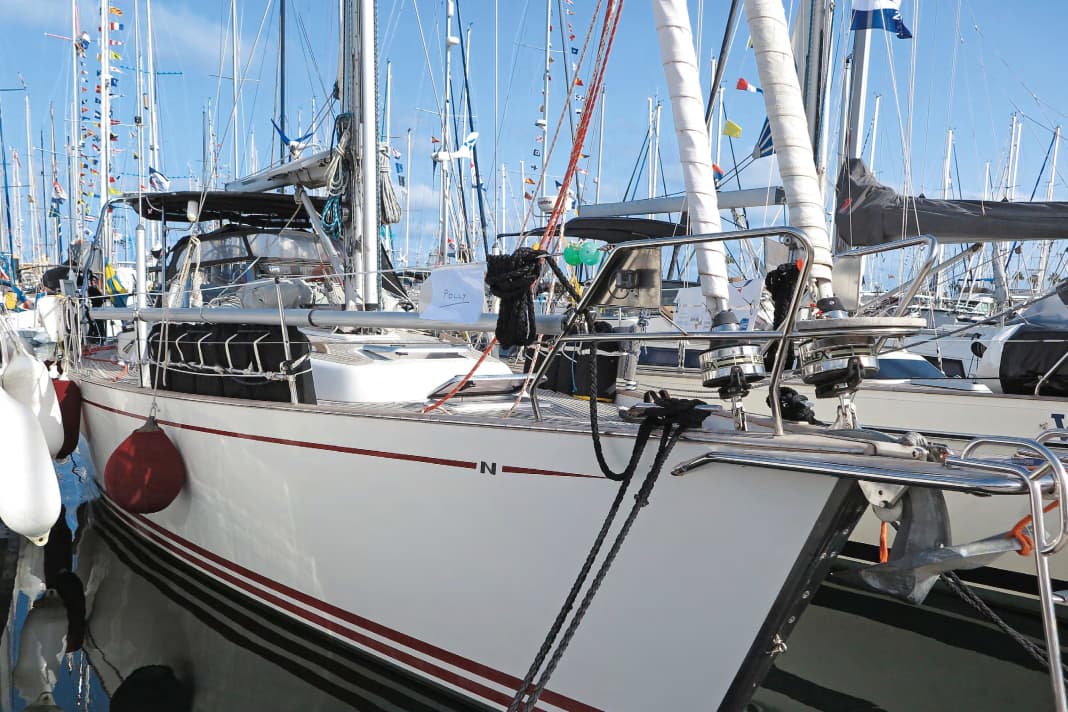



She should offer all the comforts for an extended long voyage in retirement: after an intensive search, Jörgen Bengtsson and Sarah Brooks from Sweden found what they were looking for in their Najad 405 "Polly". Having sailed on a Beneteau First 36.7 for a long time, the couple wanted the boat they were going to use to cross the Atlantic to be a little bigger and a touch more comfortable. After all, perhaps the financial expert and engineer's long voyage will take them far beyond the Atlantic. They have therefore meticulously equipped their "Polly" for self-sufficient sailing and living on board. Solar panels, a wind generator and a hydrogenerator are available to generate electricity, while a watermaker is used to supply water at sea or at anchor. The ship and its equipment are characterised by attention to detail. There are even fabric covers for the diesel canisters stowed on deck.
Technical data of the Najad 405 "Polly"
- Year of construction: 2006
- Length over everything: 12,20 m
- Width: 3,85 m
- Depth: 2,10 m
- Displacement: 12.2 tonnes (empty)
- Diesel tank:230 l
- Water tank: 480 l
- Sail:furling genoa, furling jib, furling mainsail, gennaker
Type 3: the modified series yacht
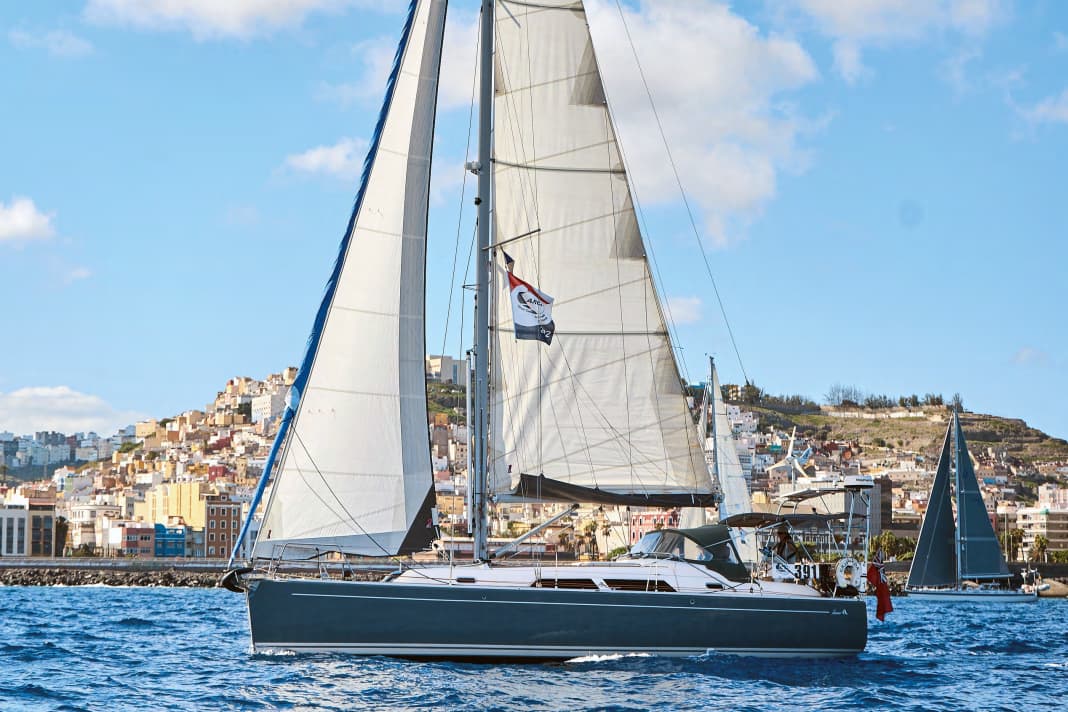



When Nicola Stamp and Gerry Baker bought their Hanse 370, they weren't thinking about a blue water cruise. Rather, the former regatta sailors from the south of England were looking for a cruising yacht that they could easily sail as a couple, including with a self-tacking jib as standard. But after a three-month tour of the Baltic, they want more and are planning an Atlantic crossing as their "next big thing". They are modifying their mass-produced yacht for the ocean: an equipment carrier including solar cells, radar and wind generator will be installed on deck, as well as a large bimini. A wind steering system is installed at the stern. They will install a passat sail, which can be set in front of the jib if required. Some things, such as the relatively small diesel tank, are not so easy to change. The couple take it in their stride: "We want to sail!"
Technical data of the Hanse 370 "Griselda"
- Year of construction: 2008
- Length over everything: 11,35 m
- Width: 3,85 m
- Depth: 1,96 m
- Displacement:7,5 t
- Diesel tank: 140 l
- Water tank: 300 l
- Sail:Mainsail, Jib, Passat sail, Spinnaker
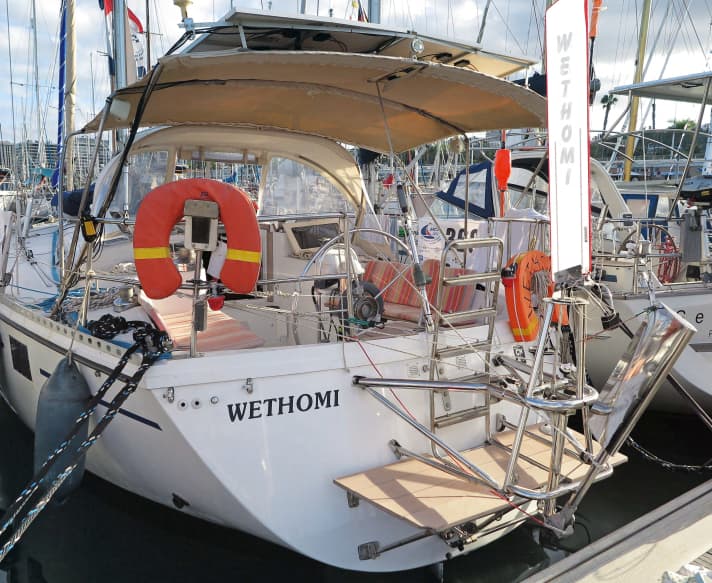
Do-it-yourself is the credo on the "Wethomi", with which owner Michael von Pilar has already crossed the Atlantic three times. He bought the boat from a new shipyard in 1982 and has travelled thousands of nautical miles on it since then. His home waters are the Mediterranean, and in 2016/17 he sailed the ship with crew to the Caribbean and back. He gradually equipped it for the planned long journeys in retirement. These included a monitor wind steering system, which he bought in the USA, as well as a hydrogenerator, solar panels and a watermaker. He constructed a bathing platform for the ship himself. He also constructed the weatherproof covering for the deck and the saloon benches. As good sun protection is a must on the trips in his favourite areas, the cockpit is covered by a bimini on which von Pilar has installed solar panels. There is also a complete cover for the dinghy to protect it from UV radiation.
I bought the boat 40 years ago. I've been doing everything on it myself ever since" - Owner Michael von Pila
Technical data of the Gib'Sea 126 "Wethomi"
- Year of construction: 1982
- Length over everything: 13,30 m
- Width: 4,05 m
- Depth: 1,80 m
- Displacement: 9 tonnes (empty)
- Diesel tank: 180 l
- Water tanks: 500 litres in total
- Sail: furling genoa, furling mainsail, parasailor, gennaker
Type 4: the customised owner's yacht
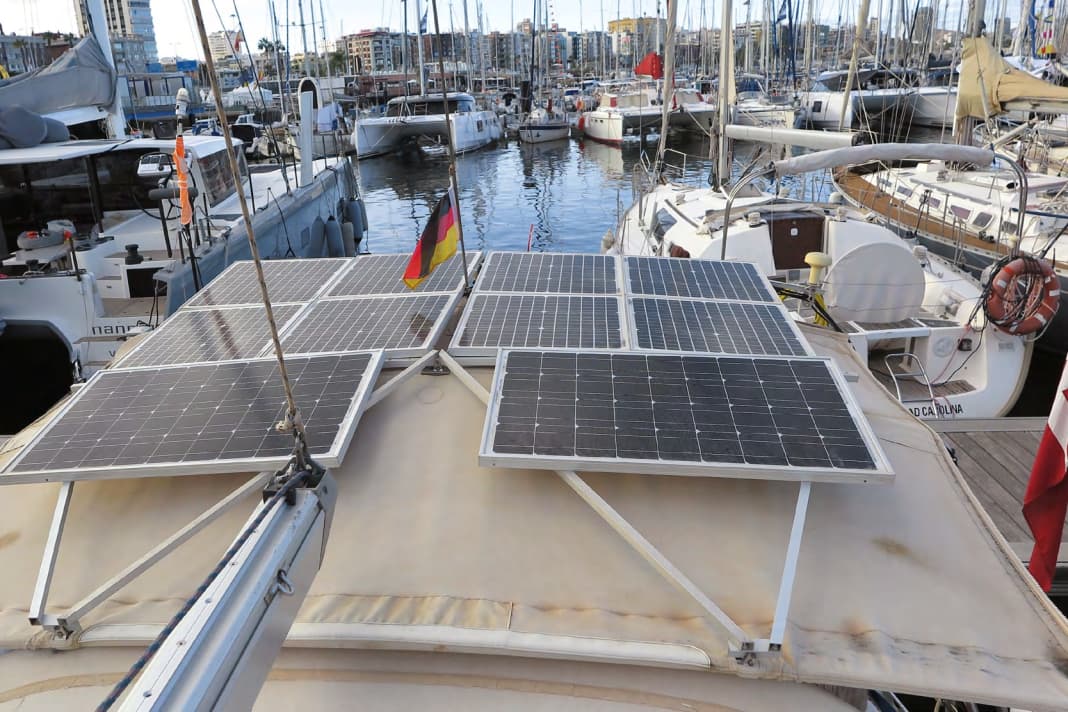



Whether multi or mono, the issue that concerns all owners equally is a self-sufficient power supply when travelling. After all, the demands on many yachts are growing. It's no longer just navigation and refrigerators that need to be powered, but also cameras, drones, water makers, washing machines, freezers and much more.
As not all crews rely on wind generators to generate energy any more, more and more space on deck is being used for solar cells. Too loud, too inefficient and the yield is not constant enough - these are the most common arguments against wind generators. However, many skippers still don't want to do without it as a power generator, especially when cruising through the night, and rely on powerful models with around 400 watts.
Particularly on yachts without equipment racks, the railing or pushpit at cockpit level has become a popular location for mounting one solar panel on the port side and one on the starboard side. Mounted on fold-out profiles, the angle to the sun can be adjusted. If they hang vertically, the sun's rays reflected from the water surface are also utilised. As a nice side effect, they provide privacy for the cockpit. But the number of black panels for sun harvesting is also increasing on equipment carriers, davits, biminis and deckhouses.
Rely on hydropower for long-distance yachts
Those who want to play it safe, such as the owners of the Najad 405 "Polly" or the Gib'Sea "Wethomi", also rely on hydropower. More and more boats are carrying a hydro generator at the stern - as long as there is enough space for it alongside the stern anchor, bathing platform and ladder as well as various rescue equipment. Models such as the Duo-Gen combine wind and water power, but have not yet caught on with the masses.
With the upgrade in terms of power generation comes the question of storage. Lithium batteries are gradually becoming the standard on blue water yachts. Of the four boats presented, three had already at least partially converted to the new technology.
Regardless of the size of the boat and what is theoretically possible, the first step in planning energy management is of course still to know your own consumption - and to reduce it if necessary.
An easier journey with the long-distance yacht
One of the biggest consumers at sea, the autopilot, is already eliminated when the wind steering system takes over. Models that can be mounted off-centre are popular with owners of newer boats with wide sterns and bathing platforms. However, the majority of ARC crews have both on board: the mechanical wind steering system as well as an electric autopilot. The redundancy of the self-steering systems gives small crews in particular the feeling of security that one is always ready to take over the exhausting steering job.
In terms of navigation and communication electronics, there is a clear trend towards simple, mobile solutions. All of the crews surveyed still had a permanently installed chart plotter on board. However, almost all of them also used a tablet with electronic nautical charts as a second or third device for the cockpit or to be able to flexibly plan and track the route anywhere on board.
Short-wave radio, on the other hand, is on the decline. Of the yachts presented, only the "Wethomi" still has an operational amateur radio system on board, which the skipper is also authorised to operate. "The radio rounds are getting smaller," reports Michael von Pilar, who already sailed across the Atlantic in both directions with the ARC in 2016. Only 19 boats were in the ARC Plus fleet in 2022. "I still really enjoy it," he says and also gets his weather information via the system connected to a Pactor modem. But it's also true what you always hear about the training for the amateur radio exam. "That was the most difficult exam I've ever taken," says von Pilar.
So it's no wonder that more and more crews are relying on satellite services, which are becoming better, cheaper and more available. The small Iridium Go mobile satellite router is used on half of the yachts presented. With a pre-booked data package and software, crews can call up weather information at sea at any time, display it on mobile devices and even calculate their own weather routing.
Sailing trend: comfort and simplicity
There is also a trend towards comfort and simplicity when it comes to sails. Wingsails such as the parasailor and furling gennakers can now be found on many yachts. In addition, crews who do not want to equip themselves with a large downwind sail still rely on the classic passat sail. Or they rig the two headsails of their cutter-rigged rig with two spinnaker poles. Nicola Stamp and Gerry Baker, owners of the Hanse 370 "Griselda", which is equipped with a self-tacking jib, had their sailmaker produce a set of flexible trade wind sails especially for the transatlantic trip, which they can set as required - similar to a gennaker with furler and torsion cable. When the large cloth is not needed, it is stored in the forward cabin, which is only used for storage anyway.
When preparing for their long voyage, Stamp and Baker deliberately decided against a watermaker. On the one hand, the acquisition costs of several thousand euros would have spoken against it. Furthermore, they argue like many long-distance sailors: if you are not sailing in extremely remote areas, you can get fresh water almost everywhere. As they don't want to live on the boat permanently, the fact that the equipment has to be preserved when not in use was also an argument against it. "With all the equipment, we try to keep the boat as simple as possible wherever possible," says Baker.
As simple as possible - it sounds like a pious wish in view of the technologies that transform modern blue water boats into self-sufficient command centres at sea. The following list shows the costs that owners can expect when upgrading their boat.
This is how much the equipment for a long-distance yacht costs
1st bow anchor:Good anchor gear is worth the money. Example: A set consisting of a galvanised 25 kg bow anchor, 50 metres of chain and an electric anchor winch costs around 2,500 euros. Stainless steel chain and anchor are significantly more expensive.
2nd headsail:A favourite combination for small long-distance crews: two headsails on furling systems. Prices vary greatly depending on the cut, cloth material and sail size.
3. radar:The antenna is gimballed or rigidly mounted on the mast, backstay or on a carrier at the stern. Current Doppler radar antennas cost a good 2,600 euros.
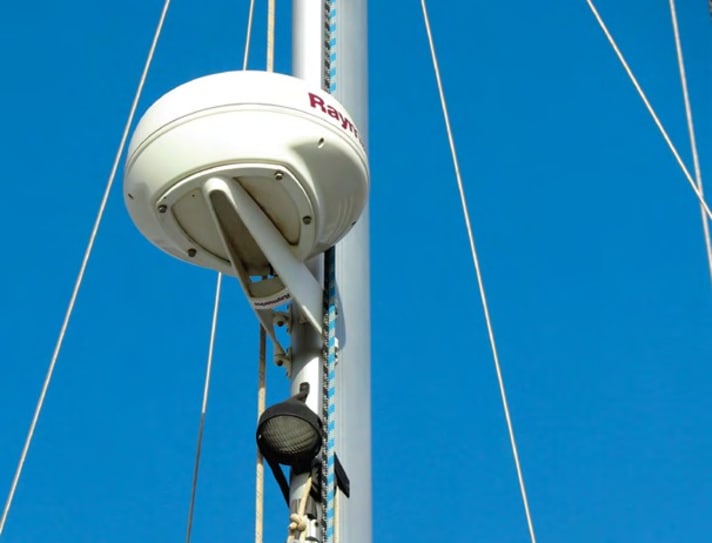
4. spinnaker poles:A spinnaker lift system for the mast, including boom extension, costs from 1,000 euros. Alternatively, the trees can be stowed on the foredeck.
5. bimini:This important sun protection is available off the peg for a few hundred euros. The tarpaulin maker will make it more expensive, but customised.
6. diesel canister:An extra supply increases the range under engine. Here, a stainless steel rod has been inserted between the railing supports to attach the canisters at sea. They are not a major cost factor.
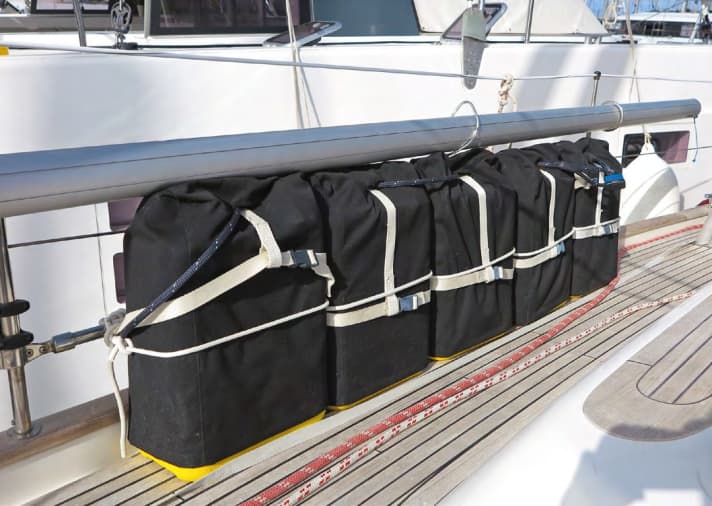
7th Spibaum sledge:If both headsails are to be hoisted at the same time, two slides on the mast are helpful. With two booms on the mast, however, the costs are doubled (point 4).
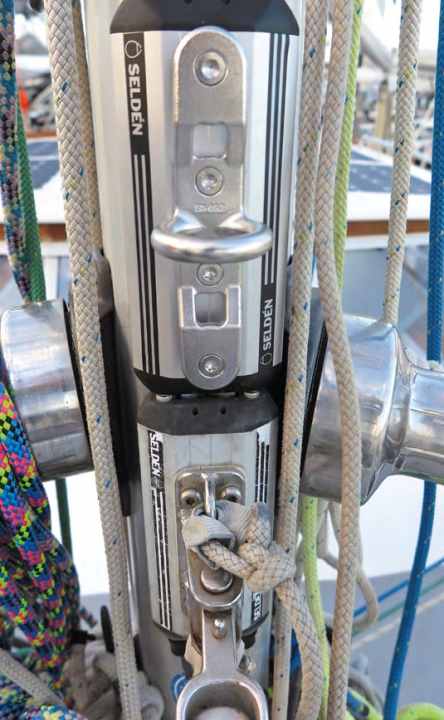
8. mast steps:Fixed aluminium mast steps cost around 80 euros each, folding ones half the price. You can also build your own. Two steps at the same height are ideal for working on the top.
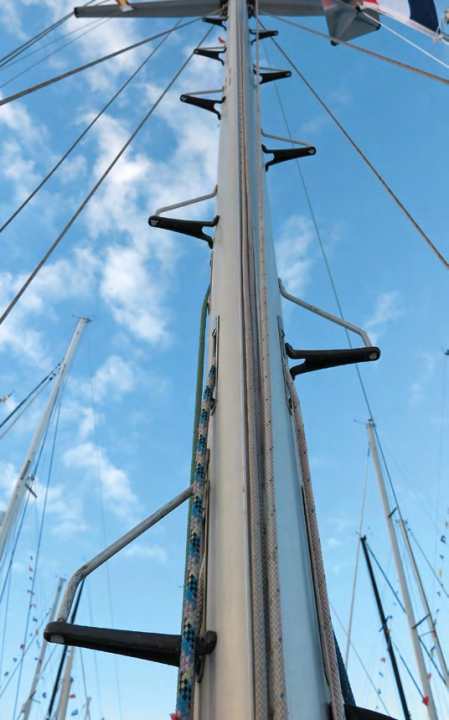
9. hydrogenerator:The swivelling turbine for generating electricity at the rear has its price: a water generator costs between 2,000 and 5,000 euros, depending on the manufacturer and output.
10. equipment carrier:The rear bars are usually custom-made from stainless steel. Prices are available on request from around 3,000 euros. However, they vary greatly depending on the company and region. It is also possible to build your own.
11. wind generator:Powerful devices with around 350 watts and more start at around 2,000 euros, smaller ones are cheaper. In addition, there are the costs for a soundproof mount.
12. solar cells:Frame modules are cheaper than flexible models. For optimum yield, they are mounted with an adjustable angle of inclination to the sun.
13. dinghy:A small, simple inflatable boat with a slatted floor for motors up to a maximum of 2.5 hp costs from around 300 euros.
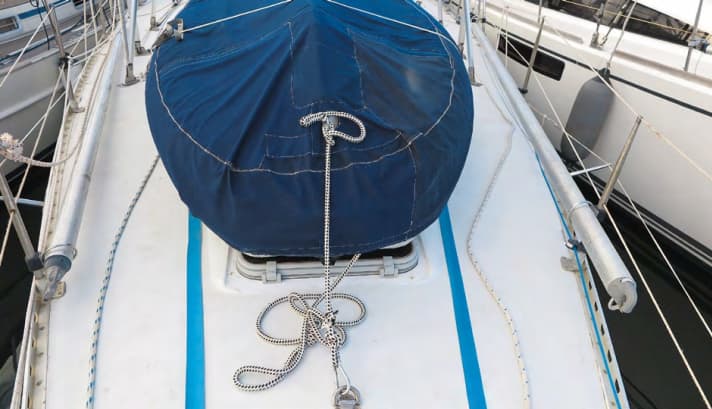
14. outboard motor:The new price for small four-strokes is just under 1,000 euros; electric models are alternatives.
15. wind steering system:Various designs are available on the market. Models for small and light boats cost around 2,000 euros, large ones with their own rudder blade around 6,000 euros.
16th bathing platform:There are models with an assembly kit for retrofitting, some with an integrated telescopic ladder. Depending on the size, they cost between around 300 and 800 euros.
17. rear anchor:Depending on the area, it is clearly driven to the trap, for example on the rear basket or a swivelling arm. Prices depend heavily on the model and size.

